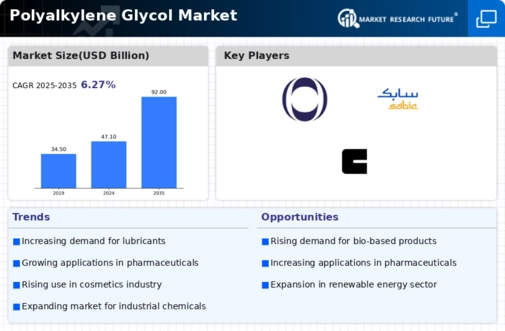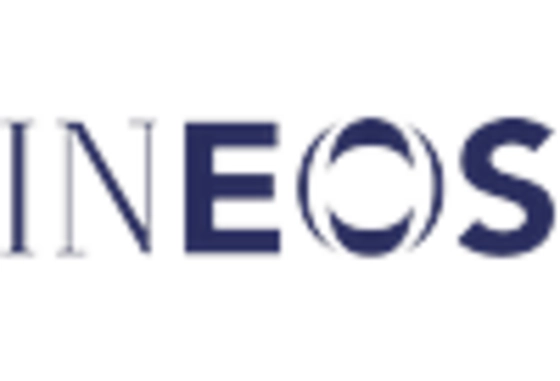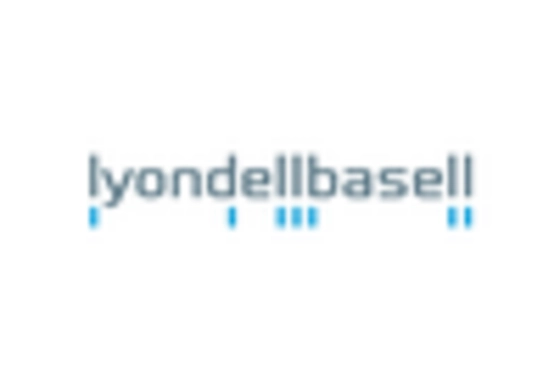Polyalkylene Glycol Size
Polyalkylene Glycol Market Growth Projections and Opportunities
The Polyalkylene Glycol Market is influenced by several key market factors that play a significant role in shaping its dynamics:
Growing Demand from End-Use Industries: The market for polyalkylene glycol is experiencing increasing demand from various end-use industries such as automotive, construction, and personal care. Polyalkylene glycols are versatile polymers used in a wide range of applications including lubricants, hydraulic fluids, polyurethane foam, and pharmaceuticals.
Rising Adoption in Automotive Sector: The automotive industry is one of the major consumers of polyalkylene glycol-based lubricants and hydraulic fluids due to their excellent thermal stability, high viscosity index, and compatibility with elastomers and seals. As the automotive sector continues to grow globally, the demand for polyalkylene glycols is expected to rise accordingly.
Expansion in Construction Activities: The construction industry utilizes polyalkylene glycols in applications such as concrete admixtures, thermal insulation materials, and sealants. With increasing construction activities worldwide, particularly in emerging economies, the demand for polyalkylene glycols is witnessing a steady growth trend.
Growing Awareness of Environmental Benefits: Polyalkylene glycols are known for their biodegradability, low toxicity, and eco-friendly characteristics, making them attractive alternatives to conventional petroleum-based products. As environmental awareness increases and regulations become more stringent, there is a growing preference for sustainable and environmentally friendly materials, driving the demand for polyalkylene glycols.
Technological Advancements: Continuous research and development efforts in the field of polyalkylene glycol chemistry are leading to the development of advanced formulations with improved performance characteristics. Innovations such as low-viscosity polyalkylene glycols, high-performance lubricants, and water-soluble polymers are expanding the application scope of polyalkylene glycols across various industries.
Growing Healthcare Sector: The healthcare industry utilizes polyalkylene glycols in pharmaceutical formulations, drug delivery systems, and medical devices due to their biocompatibility, non-toxicity, and water solubility. With the global healthcare sector experiencing robust growth, particularly in areas such as pharmaceuticals and medical devices, the demand for polyalkylene glycols in healthcare applications is expected to increase.
Fluctuating Raw Material Prices: The prices of raw materials used in the production of polyalkylene glycols, such as ethylene oxide and propylene oxide, are subject to fluctuations in the petrochemical market. Volatility in raw material prices can impact the production costs of polyalkylene glycols and, consequently, their market pricing and profitability.
Regulatory Environment: Regulatory standards and requirements imposed by government authorities regarding product quality, safety, and environmental impact influence the polyalkylene glycol market. Compliance with regulatory standards is essential for manufacturers to ensure market acceptance and maintain consumer confidence in their products.
Market Consolidation and Competition: The polyalkylene glycol market is characterized by intense competition among key players operating globally. Market consolidation through mergers, acquisitions, and strategic alliances is a common trend as companies aim to strengthen their market presence, expand their product portfolios, and enhance their competitive position.
Impact of COVID-19 Pandemic: The COVID-19 pandemic has had varying effects on the polyalkylene glycol market. While disruptions in supply chains and manufacturing operations initially impacted market growth, the pandemic has also highlighted the importance of certain applications such as pharmaceuticals and healthcare, driving demand for polyalkylene glycols in these sectors.


















Leave a Comment